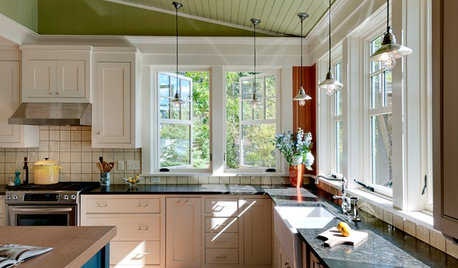new insulation in old house... which product?
doozman
15 years ago
Related Stories

GREEN BUILDINGEcofriendly Cool: Insulate With Wool, Cork, Old Denim and More
Learn about the pros and cons of healthier alternatives to fiberglass and foam, and when to consider an insulation switch
Full Story
MATERIALSInsulation Basics: What to Know About Spray Foam
Learn what exactly spray foam is, the pros and cons of using it and why you shouldn’t mess around with installation
Full Story
REMODELING GUIDESCool Your House (and Costs) With the Right Insulation
Insulation offers one of the best paybacks on your investment in your house. Here are some types to discuss with your contractor
Full Story
REMODELING GUIDESWhich Window for Your World?
The view and fresh air from your windows make a huge impact on the experience of being in your house
Full Story
GREEN BUILDINGInsulation Basics: Designing for Temperature Extremes in Any Season
Stay comfy during unpredictable weather — and prevent unexpected bills — by efficiently insulating and shading your home
Full Story
WINDOW TREATMENTSEasy Green: 9 Low-Cost Ways to Insulate Windows and Doors
Block drafts to boost both warmth and energy savings with these inexpensive but effective insulating strategies
Full Story
GREEN BUILDINGInsulation Basics: Heat, R-Value and the Building Envelope
Learn how heat moves through a home and the materials that can stop it, to make sure your insulation is as effective as you think
Full Story
GREEN BUILDINGInsulation Basics: Natural and Recycled Materials
Consider sheep’s wool, denim, cork, cellulose and more for an ecofriendly insulation choice
Full Story
KNOW YOUR HOUSEKnow Your House: The Basics of Insulated Concrete Form Construction
Get peace and quiet inside and energy efficiency all around with this heavy-duty alternative to wood-frame construction
Full Story
MIDCENTURY STYLEWhich ‘Mad Men’ Prop Would You Like for Your House?
Fancy a pair of Don Draper’s office chairs or Peggy’s blue typewriter? Vintage props from the TV show are up for auction
Full Story







lucy
marys1000
Related Professionals
East Peoria Kitchen & Bathroom Designers · Highland Kitchen & Bathroom Designers · Manchester Kitchen & Bathroom Designers · Montrose Kitchen & Bathroom Designers · Queen Creek Kitchen & Bathroom Designers · Eagle Mountain Kitchen & Bathroom Remodelers · Feasterville Trevose Kitchen & Bathroom Remodelers · Fort Pierce Kitchen & Bathroom Remodelers · Oceanside Kitchen & Bathroom Remodelers · Paducah Kitchen & Bathroom Remodelers · Hawthorne Kitchen & Bathroom Remodelers · Brushy Creek Architects & Building Designers · Dayton Architects & Building Designers · Palmer Architects & Building Designers · Seal Beach Architects & Building Designersfandlil
lucy
housekeeping